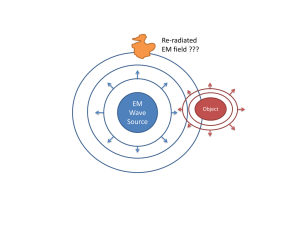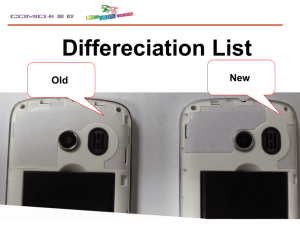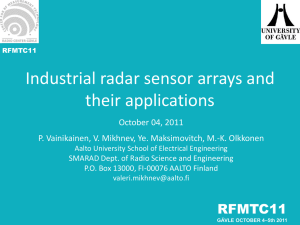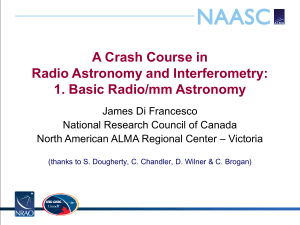Amateur Radio Astronomy
advertisement
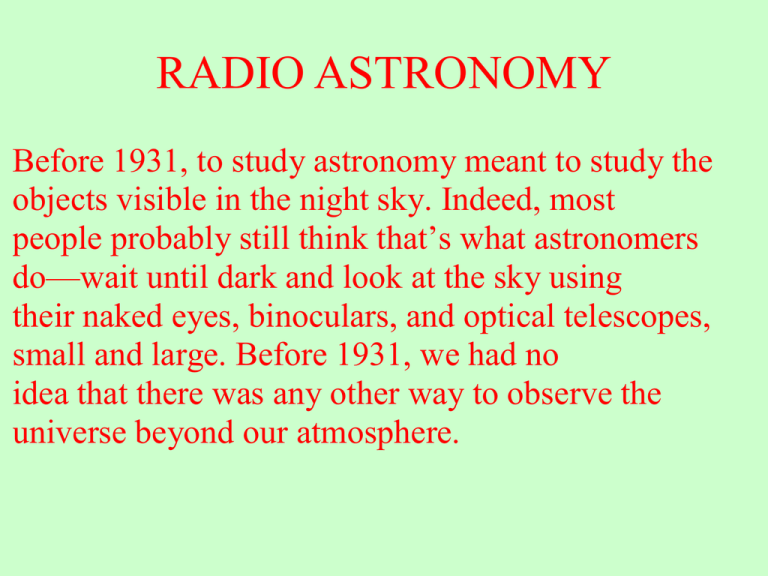
RADIO ASTRONOMY Before 1931, to study astronomy meant to study the objects visible in the night sky. Indeed, most people probably still think that’s what astronomers do—wait until dark and look at the sky using their naked eyes, binoculars, and optical telescopes, small and large. Before 1931, we had no idea that there was any other way to observe the universe beyond our atmosphere. JANSKY’s EXPERIMENT As often happens in science, major discoveries happen while someone was looking for something else. Karl G. Jansky (1905-1950) worked as a radio engineer at the Bell Telephone Laboratories in Holmdel, New Jersey. In 1931, he was assigned to study radio frequency interference from thunderstorms in order to help Bell design an antenna that would minimize static when beaming radio-telephone signals across the ocean. He built an unusual radio array that looked more like a wooden merry-go-round than like any modern-day antenna, much less a radio telescope. It was tuned to respond to radiation at a wavelength of 14.6 meters (20 Mhz) and rotated in a complete circle on old Ford tires every 20 minutes. The antenna was connected to a receiver and the antenna’s output was recorded on a strip-chart recorder. He was able to attribute some of the interference for noise produced by nearby thunderstorms, and some of it to far away thunderstorms, but some of it he couldn’t place. He called it “a steady hiss type static of unknown origin.” As his antenna rotated, he found that the direction from which this unknown static originated changed gradually, going through almost a complete circle in 24 hours. He was no astronomer, and it took him a while to surmise that the static must be of extraterrestrial origin, since it seemed correlated with the rotation of Earth. At first he thought the source was the sun. However, he observed that the radiation peaked 4 minutes earlier each day. He knew that Earth, in one complete orbit around the sun, necessarily makes one more revolution on its axis with respect to the sun than the approximately 365 revolutions Earth has made about its own axis. Thus, with respect to the stars, a year is actually one day longer than the number of sunrises or sunsets observed on Earth. So, the rotation period with respect to the stars (known to astronomers as a sidereal day) is about 4 minutes shorter than a solar day (the rotation period of Earth with respect to the sun). Jansky therefore concluded the source of this radiation must be much farther away than the sun. With further investigation, he identified the source as the Milky Way and, in 1933, he published his findings. Grote Reber’s Prototype Radio Telescope Despite the implications of Jansky’s work, both on the design of radio receivers, as well as for radio astronomy, no one paid much attention at first. Then, in 1937, Grote Reber, another radio engineer, picked up on Jansky’s discoveries and built the prototype for the modern radio telescope in his back yard in Wheaton, Illinois. He started out looking for radiation at shorter wavelengths, thinking these wavelengths would be stronger and easier to detect. He didn’t have much success, however, and ended up modifying his antenna to detect radiation at a wavelength of 1.8 meters (about the height of a human), where he found strong emissions along the plane of the Milky Way. (This frequency is about 160 Mhz) Reber continued his investigations during the early 40s, and in 1944 published the first radio frequency sky maps. Up until the end of World War II, he was the lone radio astronomer in the world. Meanwhile, British radar operators during the war had detected radio emissions from the Sun. After the war, radio astronomy developed rapidly, and has become of vital importance in our observation and study of the universe. Today … Why Study Radio Astronomy? • Radio astronomy gives us a view of the universe that is not possible using our eyes and visible light. • Electromagnetic effects are complex and frequency dependent. • Radio waves can sometimes penetrate gas and dust and allow views that otherwise would be obscured. Radio astronomy gives us a view of the universe that is not possible using our eyes and visible light. • Typical nighttime view of a starry night: Radio astronomy gives us a view of the universe that is not possible using our eyes and visible light. • Radio view at 460 Mhz Electromagnetic effects are complex and frequency dependent. • Our view of the universe would be extremely limited using visible light alone TV Channel 2 (Red light) Channel 3 Channel 4 (Yellow light) (Gr/Blue light) TV Channel 5 (Violet light) We would no nothing of the AM broadcast band, short-wave, the rest of the TV band, FM, public service, radar, microwave, wireless, cellular, etc. since we are only peering at a limited range of the electromagnetic spectrum. Radio waves can sometimes penetrate gas and dust and allow views that otherwise would be obscured • The notable example, here, was the discovery of a massive Black Hole at the center of our own galaxy that is completely invisible in the visible light region (due to obscuring dust) • This object has been mapped and resolved at several different radio Frequencies, and subsequent radio discoveries have led to the conclusion the Black Holes exist at the heart of other galaxies as well. Amateur Radio Astronomy • Amateurs in Radio Astronomy can do quite a bit of useful work • Even with very modest equipment • Simple short-wave receiving systems are all that is required, for example, to capture Solar Flares, and detect radiation from Jupiter, and the Center of our own Galaxy. SIMPLE RADIO TELESCOPE BLOCK DIAGRAM • This diagram depicts a simple Total Power Radiometer that can be used to capture Solar flares, Jupiter noise and detect the Galactic Continuum Radiation: Dipole antenna ………. Length / side (feet) = 234 / F (Mhz) Coax transmission line Detector and filter (detail next slide) Interface ht ~20 ft above gnd AM or SSB Radio receiver Manual gain Headphone output Tuned to a quiet frequency ~ 20Mhz Chart recorder (or DC voltmeter) Detector/ Filter Detail • Pictorial of a simple Peak Envelope Detector for a Total Power Radio Telescope Input from headphone jack or speaker 500 ohms CR1 (1N914) DC Output to chart recorder + 10 K R1 C1 1000 uF R2 Recordings from Similar equipment Solar Flare ~ 20Mhz (Relative Amplitude Calibration) Jupiter Noise Blue ~ 18 Mhz Red ~ 20 Mhz Gallactic Center Scan at UHF What makes a Radio Telescope Different than a Optical Telescope? Optical Telescope responds to energy as excited Photons Radio Telescope responds to energy that relates to Temperature of Lower Frequency Electromagnetic Waves System Sensitivity The minimum theoretical Radiometer detectable temperature (Tmin) is: Tmin = Te —————— ( (B ) where: Te is the equivalent Receiver Noise temperature* :Te = (F - 1) T0, i.e. F = Receiver Noise Factor, and T0 is standard Temperature (290 ° K) B = Receiver bandwidth in Hz and = the integration Time Constant after detection * Noise factor (F) is related to Noise Figure (NF), i.e., F = 10 (NF / 10) Noise Figure is expressed in dB, a logarithmic quantity expressing ratios of power Sensitivity example Receiver Noise Figure = 5 dB Bandwidth = 10 Khz (10000 Hz) = 10 seconds What is Tmin for this System? 1) First calculate F and Te: F = 10 (NF/10) = 10 (5/10) = 3.16 Te = (F - 1) T0 = (3.16 -1) (290) = 626.4 ° K 2) Next Calculate Tmin: Tmin = Te / (B ) = 626.4 / (10000 x 10) Tmin = 1.98 ° K Could my simple total power radiometer achieve this level of sensitivity in practice? Probably not ….. It would be necessary to stabilize the gain of this receiver to better than 1 part in 330* to effect this level of performance. This would be a significant design challenge and would require special signal processing techniques that usually are not included in a general purpose Short wave Receiver. * Even more stabilization is required in extremely sensitive Receiver systems Some of these special techniques would include: 1) Noise Injection where a calibrated amount of noise is injected into thesystem front end and then subtracted out of the output to remove gain variations 2) Dicke switching where the input to the receiver is alternately switched back and forth between the antenna and a termination at “room temperature”. The output is then differentially processed to extract the antenna signal alone 3) Phase switching where the phase of the signal is chopped between 0 and 180 degrees, then multiplied, which extracts the original antenna information It is not necessary to employ any of these special techniques for Relative power measurements where precise calibration and stability are not required Such is the case for the Solar and Jupiter cases that were already mentioned. What about resolution? Resolution of a telescope is the ability to separate discrete sources that are nearly co-located in space It is a function of aperture area, just as in an Optical Telescope, and, in general, the larger the antenna, the greater the resolution. It is interesting to point out that the largest single Radio Telescope with unprocessed data has less resolution than the human eye. Do I need high resolution? Again, no, not initially for the types of Radio Astronomy that we discussed. Resolution is important for precise source locating or for mapping the radio sky. Large antenna arrays are required for these activities with special electronic circuits to distribute the power properly between the antenna elements. Types of Radio Telescopes In general there are 2 distinct types of Radio Telescopes (Radiometers): 1) Total Power ….. Where all of the radio energy is confined within a single antenna beam 2) Interferometer ….. Where the radio energy is split into a Multi-Lobed Pattern between the elements of an antenna array in order to increase the telescope resolution Interferometer Block Diagram 4 Antenna Array Interferometer n 4 way Power Combiner n Receiver n Output Recorder The individual antennas of the Interferometer are spaced several wavelengths () apart to increase the resolution over a single antenna where: = c0 / f c0 = 3 x 10 8 meters /sec, and f = center frequency of the Receiver in Hz Beamwidth of individual antenna Composite Beamwidth of Interferometer array where Beamwidth is defined as the location on the antenna lobes where the power falls to 1/2 of the value on boresite Is Antenna tracking required? Antenna tracking is not required if the instrument is used as a Meridian Transit System In this case the antenna is fixed (usually South) and the source “drifts” through the antenna beam due to earth’s rotation. What does the output of a Radiometer represent? Noise Energy … usually expressed in terms of Antenna Temperature or Flux Units which are related to Antenna Temperature and Effective Antenna Area These quantities are similar to the “Magnitude” units that are familiar to optical astronomers. Recall that Noise Power in a system is equal to: P = K Ta B where: P = received excess noise power in watts K = Boltzmann’s Constant (1.38 x10 -23 Joules / K) Ta = Absolute Temperature in K and B = Receiver Bandwidth in Hz Solving for Ta: Ta = P / (K B) Ta is measured as excess noise output from the Receiver and is then compared to the level obtained from a standard noise source for accurate calibration. For strictly “relative” measurements, accurate calibration is not required. Flux Units can be derived from Antenna Temperature The units of Flux (S) are watts / meter2 / Hz and are expressed by: Flux (S) = K Ta / Ae where: Ae is the effective antenna area and is given by: Ae = G 2 / (4 ) where: G is the Directive Gain of the antenna array 1 Flux Unit = 10 -26 watts / m2 / Hz and is defined as 1 Jansky You got my interest, but describe some advanced topics? 1) 2) 3) 4) 5) Multi-channel receivers ….. where events are captured on multiple frequencies then correlated in amplitude and phase Digital Signal Processing where the receiver output is first digitized, then injected and analyzed in a computer system. Numerical analysis can then be applied as required Pulsar periodicity measurements which can then be correlated with optical views Hydrogen line studies (1420.1Mhz) To map the location and quantity of ionized hydrogen within the non-visible universe And of course ……... SETI Search For Extraterrestrial Intelligence Large antennas, multi-channel receivers, digital storage, and a radio quiet location are required for SETI research. Nonetheless, many radio astronomy enthusiasts are involved in this interesting activity, including some of the professional radio observatories when there is down time on the telescopes. More information? Web sites: www.wy2u.com http://www2.jpl.nasa.gov/radioastronomy/ http://www.geocities.com/CapitolHill/1090/ws1_4.html http://www.draco.scsu.edu/radioastro.html

